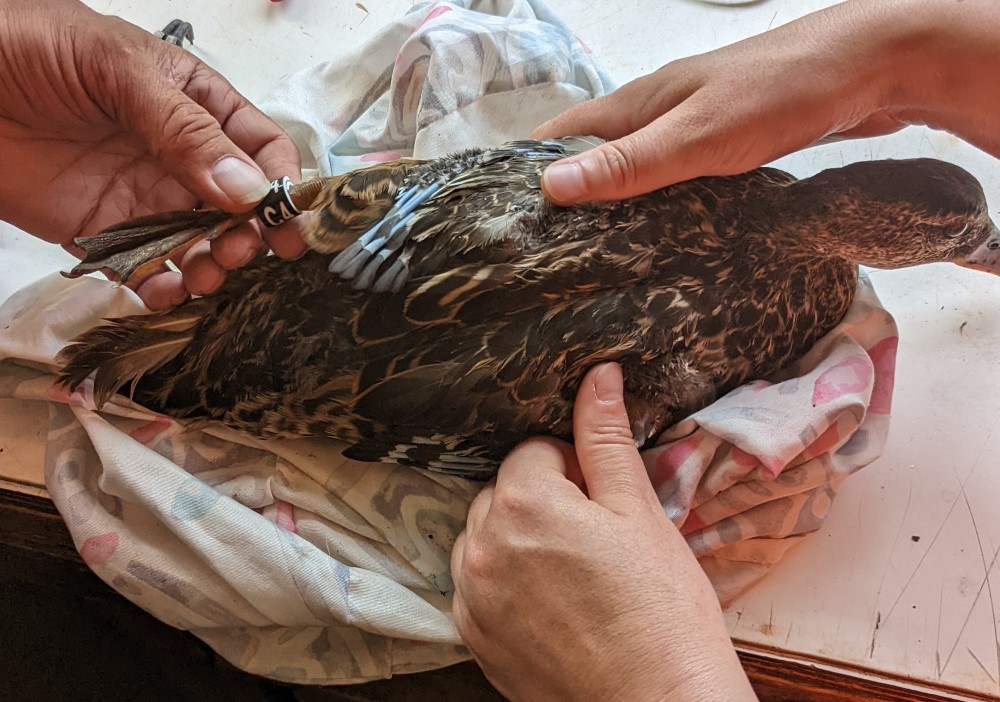Observations

A Gadwall in full wing moult is colour-ringed
July – August 2022 – hot, hot, hot…
A fairly arduous couple of months, for birds and ringers alike, with ongoing drought conditions and record high temperatures. Not that drought matters much to waterbirds on our lagoons.
It didn’t help that our leading duck counter, breeding surveyor and generally useful chap, AH, suffered a serious hand injury and, as they say on the sports pages, “will need several weeks in the treatment room before he’s out on the grass again”.
Climate concerns notwithstanding, a good breeding season has been reflected in decent numbers of migrants passing through as Autumn got under way in earnest.
The biggest news on the waterfowl front has been the development this year of a sizeable flock of flightless ducks, particularly Gadwalls., which reached an impressive 572 in July, a record count for Rye Meads. We were able to catch a small part of this flock, and hopefully if this is repeated in the years ahead we might get some recoveries or ring sightings to help determine the origins of these birds. By early August, the count was already down to 190 – still pretty good for August – as newly moulted birds presumably set off for whatever winter quarters they favoured.
Also notable was the presence of a pair of moulting Garganeys in late July; these two had become six by late August. That’s our best Garganey count since nine in 1993.
Other duck news included Shovelers building slowly from single figures and reaching 26 by the end of August; and Teal similarly slowly increasing to 22. Meanwhile our lonely Wigeon remained throughout. There were up to six Red-crested Pochards in July, and one day saw five adults plus two juveniles, arguably our record count for this species after six last year.
Not wishing to tempt fate, but at least there has been no evidence to date of avian flu in our waterbird population.
Top ‘wader’ billing perhaps goes to the Great White Egret seen in August. Sightings of this species are now almost routine: it’s hard to remember that this is only our 8th record, the second this year, and that we only recorded it for the first time in 2014. Meanwhile Little Egret notched up a best count of 10, one shy of our record.
On to what you might call proper waders, Not the greatest wader fest ever, but records of a single Black-tailed Godwit followed a few days later by three adults was welcome. Four Greenshanks one July day was also good for a species not quite annual in occurrence. A Dunlin in August completes the round-up of coastal waders.
More routinely, there were up to five Little Ringed Plovers, four Oystercatchers and six Lapwings.
A single Mediterranean Gull joined the usual gulls, and up to seven Common Terns finally gave up on a disastrous breeding season.
It’s been a while since we hosted a significant roost of hirundines, so we were pleased to count 100 Swallows and 20 Sand Martins going into the reeds of 2nd Meadow in late August, and even more pleased to catch a decent number of them, including a couple ringed elsewhere, whose details we await with interest.
There have been good numbers of warblers passing through the site. Two counts of 30 Chiffchaffs, one of 25 and two of 20 are likely to be underestimates: it is hard to assess how many small, discreet birds are on site at any one time. It’s been a better year for Willow Warblers than for some time, with the best count one of eight.
Acrocephalus warblers are even harder to count; so it’s lucky that Grasshopper Warblers presented themselves for census in a net on two dates.
Sylvia warblers seemed plentiful, with maximum counts of 80 Blackcaps and 17 Garden Warblers – our best Garden Warbler count since 2014. Top count of Whitethroat was just ten, and there were up to three Lesser Whitethroats.
Perhaps the star Passerine to date was the Spotted Flycatcher noted in North Lagoons. There were just two sightings of Yellow Wagtail, and up to nine Pied Wagtails in August was respectable by recent standards.
And finally, a flock of eight Linnets was again respectable by recent standards, if a far cry from the Rye Meads record of 1,000 back in 1972. Those were the days…
